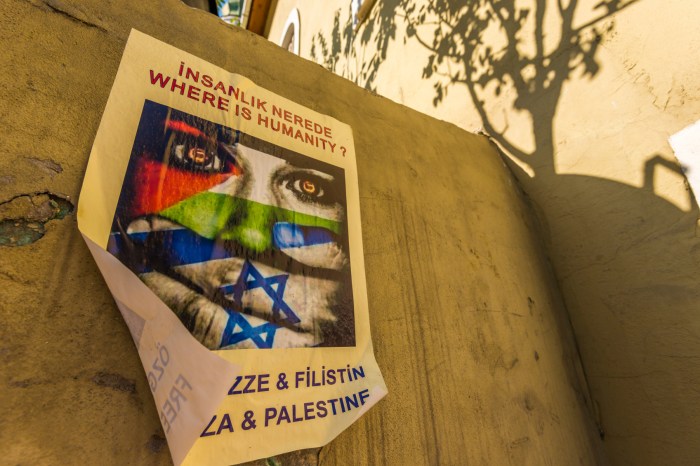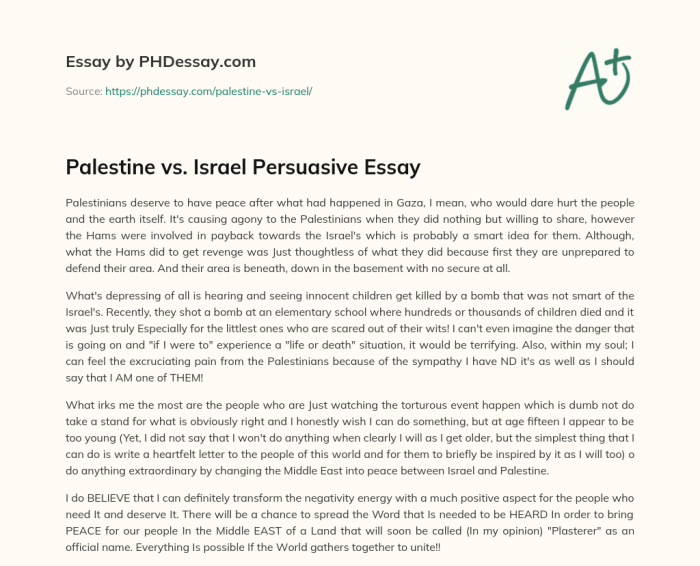Essay on israel and palestine conflict – The essay on the Israel and Palestine conflict delves into the intricate historical, political, and social dynamics that have shaped this protracted struggle. From the contested origins of the conflict to the ongoing challenges of territorial disputes, violence, and human rights violations, this essay provides a comprehensive analysis of the key issues at stake.
The essay explores the complex interplay between Israeli and Palestinian political structures, the role of international organizations, and the impact of media coverage on public perception. It examines the social and cultural divisions within both societies and analyzes the economic consequences of the conflict on both sides.
Historical Context

The conflict between Israel and Palestine has a long and complex history, rooted in political, religious, and territorial disputes. The key events in the timeline of the conflict include:
- 1917: The Balfour Declaration, issued by the British government, pledged support for a Jewish homeland in Palestine.
- 1948: The Arab-Israeli War resulted in the establishment of the State of Israel and the displacement of hundreds of thousands of Palestinians.
- 1967: The Six-Day War led to Israel’s occupation of the West Bank, Gaza Strip, and East Jerusalem.
- 1973: The Yom Kippur War, in which Egypt and Syria attacked Israel, ended with a ceasefire and negotiations.
- 1993: The Oslo Accords were signed, establishing the Palestinian Authority and beginning the peace process.
- 2000: The Camp David Summit failed to resolve the conflict, leading to the outbreak of the Second Intifada.
- 2005: Israel withdrew from the Gaza Strip, but the conflict continued with ongoing violence and sporadic peace negotiations.
Different perspectives exist on the origins of the conflict, with some emphasizing the historical claims of both sides to the land, while others focus on the political and ideological factors that have shaped the conflict.
Political Landscape
Israel is a parliamentary democracy with a president, prime minister, and Knesset (parliament). The current Prime Minister is Benjamin Netanyahu. The Palestinian Authority is the governing body of the Palestinian territories, which include the West Bank and Gaza Strip. The President of the Palestinian Authority is Mahmoud Abbas.
International organizations play a significant role in the conflict. The United Nations has been involved in peace negotiations and humanitarian assistance, while the European Union and the United States provide financial and political support to both sides.
Territorial Disputes

The disputed territories in the conflict include the West Bank, Gaza Strip, and East Jerusalem. These territories are significant for both Israelis and Palestinians, with religious, historical, and political importance.
The challenges of land division and resource allocation are complex. Israel claims the right to the entire territory, while the Palestinians seek to establish an independent state in the West Bank and Gaza Strip, with East Jerusalem as its capital.
Security and Violence: Essay On Israel And Palestine Conflict
The conflict has been characterized by ongoing violence, including terrorism, military operations, and civilian casualties. According to the UN, over 10,000 Palestinians and 3,000 Israelis have been killed since 2000.
The causes of terrorism and military operations are complex, involving political grievances, religious extremism, and territorial disputes. The consequences include loss of life, destruction of property, and social and economic disruption.
Human Rights and Humanitarian Concerns

Both Israelis and Palestinians have experienced human rights violations, including arbitrary arrests, torture, and extrajudicial killings. The Israeli occupation of the West Bank and Gaza Strip has raised concerns about the treatment of Palestinians under military rule.
International organizations, such as the UN Human Rights Council and Amnesty International, have documented and condemned human rights violations in the conflict.
International Diplomacy and Peace Efforts
Numerous peace negotiations and agreements have been attempted over the years. The most notable include the Oslo Accords (1993), the Camp David Summit (2000), and the Annapolis Conference (2007).
The challenges and obstacles to achieving a lasting peace are significant, including the deep-rooted mistrust between the two sides, the ongoing violence, and the territorial disputes.
Media Coverage and Public Perception
The media plays a crucial role in shaping public opinion on the conflict. News coverage often reflects the political biases and perspectives of the respective media outlets.
Bias and propaganda can influence the perception of the conflict, with each side presenting a narrative that supports its own interests and delegitimizes the other.
Social and Cultural Impacts
The conflict has had profound social and cultural impacts on both Israeli and Palestinian societies. The ongoing violence and occupation have led to divisions within communities, mistrust, and a sense of alienation.
The conflict has also affected education, with Israeli and Palestinian students often receiving different narratives about the history and nature of the conflict.
Economic Consequences
The conflict has had significant economic consequences for both Israel and Palestine. The ongoing violence and political instability have hindered economic growth and development.
Sanctions, trade restrictions, and investment uncertainties have exacerbated the economic challenges. The occupation of the Palestinian territories has also created economic disparities between Israelis and Palestinians.
Regional and Global Implications

The conflict has had regional and global implications. The ongoing violence and instability have contributed to tensions in the Middle East and beyond.
The potential for the conflict to escalate or spread remains a concern for the international community. The conflict also raises questions about the role of international law and the responsibility of the international community to address human rights violations.
Key Questions Answered
What are the key historical events that have shaped the Israel-Palestine conflict?
The conflict has its roots in the early 20th century, with the rise of Zionism and the establishment of the British Mandate for Palestine. Key events include the 1948 Arab-Israeli War, the Six-Day War in 1967, and the Oslo Accords in the 1990s.
What are the main political structures and leaders involved in the conflict?
Israel is a parliamentary democracy, while Palestine is governed by the Palestinian National Authority. Key leaders include Israeli Prime Minister Benjamin Netanyahu and Palestinian President Mahmoud Abbas.
What role have international organizations played in the conflict?
International organizations such as the United Nations, the European Union, and the United States have been involved in peace negotiations and humanitarian assistance. However, their efforts have often been hampered by political divisions and lack of consensus.
What are the main challenges to achieving a lasting peace in the conflict?
Major challenges include territorial disputes, the issue of Palestinian refugees, and the ongoing violence and mistrust between the two sides. Resolving these issues will require significant political will and compromise from both Israelis and Palestinians.